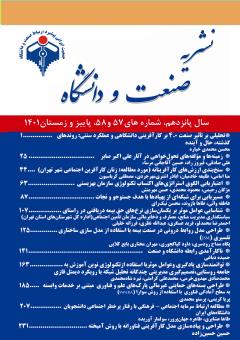مطالعه ارتباط سرمایه اجتماعی - فرهنگی با رفتار پرخطر اجتماعی دانشجویان دانشگاه¬های ایران
محورهای موضوعی : عمومی
طاها عشایری
1
![]() ,
طاهره جهان پرور
2
,
طاهره جهان پرور
2
![]() ,
سولماز آوریده
3
,
سولماز آوریده
3
![]()
1 - استادیار دانشكده علوم اجتماعي و عضو هئیت علمی گروه تاریخ و علوم اجتماعی علوم اجتماعي دانشگاه محقق اردبیلی، اردبیل، ایران
2 - دانشجوی دکترای جامعه شناسی فرهنگی، گروه علوم اجتماعي دانشكده علوم اجتماعي ارتباطات و رسانه، دانشگاه آزاداسلامی، واحد تهران
3 - استادیارگروه علوم اجتماعی دانشگاه پیام نور، تهران، ایران
کلید واژه: سطح سرمایه اجتماعی, سرمایه فرهنگی, رفتار پرخطر اجتماعی دانشگاهیان, سبک زندگی دانشجویان, دانشگاه. ,
چکیده مقاله :
رفتارهای پرخطر در میان دانشجویان یکی از مسائل دانشگاهی و آموزش عالی کشور محسوب میشود، اعتیاد، دخانیات، رفتارهای پرخطر جنسی، رانندگی خطرناک، قانونگریزی و غیره، به کاهش کیفیت نظام دانشگاهی، افت تحصیلی و سلطه مسائل اجتماعی منفی بر فضای کلی نظام آموزشی شده است. سرمایه اجتماعی و فرهنگی نقش مهمی در کاهش رفتارهای پرخطر اجتماعی در میان دانشجویان دارد. روش تحقیق حاضر از نوع فرا تحلیل کمی و مرور سامانمند با تکیهبر منابع و اسناد علمی منتشرشده از سایت نورمگز، مگ ایران و ایران داک دربازه زمانی 1390-1403 است. از جامعه آماری 24 پژوهش، با رعایت مراحل غربالگری و ملاک ورود (پیمایش و کمی بودن، دارا بودن حجم نمونه و ضریب همبستگی پیرسون و اسپیرمن، سطح معنیداری و اعتبار علمی)، 13 سند به روش نمونهگیری غیراحتمالی (تعمدی و دسترس)، انتخاب و وارد نرمافزار cma2 شده است. آزمون مورداستفاده d کوهن و f فیشر و آزمونهای Q است. درنهایت ضریب اندازه اثر (effect size) کوهن و فیشر نشان میدهد که سرمایه اجتماعی (31 درصد) و سرمایه فرهنگی (36 درصد) از تغییرات رفتار پرخطر دانشجویان را تبیین کرده و جهت این تأثیر معکوس است، همچنین سرمایه فرهنگی و اجتماعی (شاخص کلی سرمایه) بهطورکلی 41 درصد (معکوس) از تغییرات رفتار پرخطر اجتماعی را پیشبینی نموده است. درنهایت با افزایش سرمایه اجتماعی و فرهنگی به دلیل ارتقای ساختار حمایتی، انسجامی، مشارکتی، اعتماد و بهبود منزلت فرهنگی، آگاهی و سواد فرهنگی؛ از عادی شدن کنشهای منفی، ناهنجارانه و پرخطر ممانعت نموده و تدریجی فضای دانشگاهی تبدیل به محیطی سالم، بهنجار و خودکنترلگر میگردد.
High-risk behaviors among students is considered one of the issues of university and higher education in the country, addiction, smoking, high-risk sexual behaviors, dangerous driving, evasion of the law, etc., have reduced the quality of the academic system, academic decline, and the dominance of negative social issues on the overall atmosphere of the educational system. Social and cultural capital plays an important role in reducing risky social behaviors among students. The current research method is quantitative meta-analysis and systematic review based on sources and scientific documents published on Normagz, Iran Mag and Iran Doc sites in the period of 1403-1390. From the statistical population of 24 studies, following the screening steps and inclusion criteria (survey and quantitative, having sample size and Pearson and Spearman correlation coefficient, significance level and scientific validity), 13 documents were selected by non-probability sampling method (purposive and available). and entered into the cma2 software
The tests used are Cohen's d, Fisher's f, and Q tests. Finally, the effect size coefficient of Cohen and Fisher shows that social capital (31%) and cultural capital (36%) explain the changes in risky behavior of students and the direction of this effect is opposite, as well as cultural and social capital (general index) capital) has generally predicted 41% (inverse) of changes in risky social behavior.
Finally, with the increase of social and cultural capital due to the promotion of support structure, cohesion, partnership, trust and improvement of cultural dignity, awareness and cultural literacy; It prevents the normalization of negative, abnormal and dangerous actions and gradually the academic environment becomes a healthy, normal and self-controlling environment
